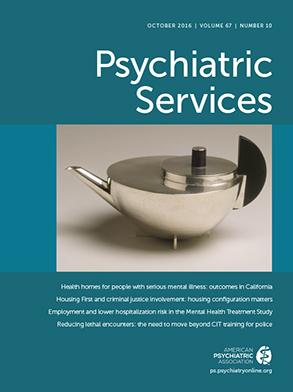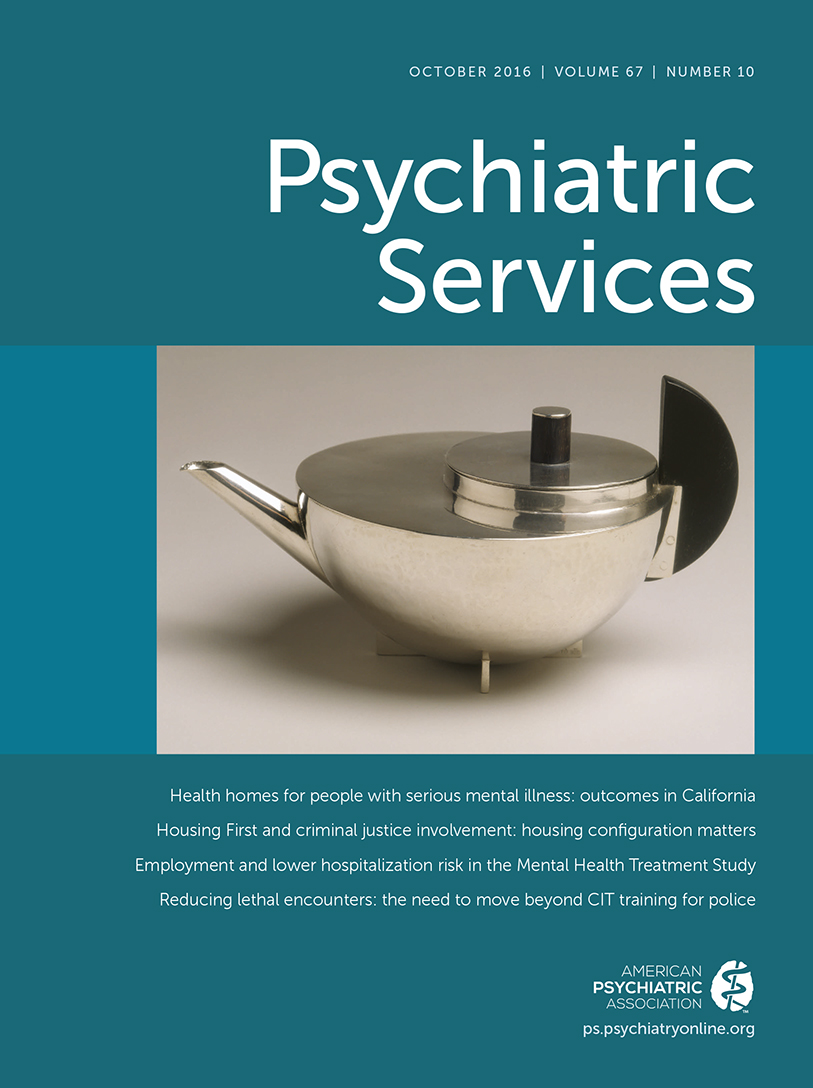The Social Security Administration’s (SSA’s) Mental Health Treatment Study (MHTS) was a randomized controlled trial involving more than 2,000 participants with psychiatric disabilities at 23 sites around the United States. The trial examined a comprehensive package of insurance coverage, mental health treatments (including systematic medication management), vocational services (supported employment based on the Individual Placement and Support [IPS] model), and suspension of disability reviews and compared this approach with treatment as usual for Social Security Disability Insurance (SSDI) beneficiaries with psychiatric impairments (
1). The clinical outcomes were clear. Many people with SSDI (a majority) returned to some competitive work, improved their mental health status, and increased their quality of life (
2). Most participants worked part-time, however, and with rare exception did not exceed the SSA’s defined “substantial gainful activity” limit, even for a short period.
Since the end of the study in 2010, public concerns have escalated regarding the Social Security Trust Fund, and the goal of reducing overall SSDI expenditures (not a goal of MHTS) has become a political priority. Therefore, MHTS investigators have met many times to review findings from the study, as new analyses uncover more results, and to consider policy issues. This report summarizes the consensus among our group regarding implications for public health and disability policy. Some conclusions stem entirely from the MHTS, and others are related to the larger corpus of research on psychiatric disability. We clarify these distinctions in the discussion.
Policy Implications
Benefits of MHTS interventions.
The MHTS package, including IPS supported employment, was a helpful service for SSDI beneficiaries who wanted to work because it facilitated important clinical and societal goals. Over 60% of MHTS participants who received the experimental interventions achieved part-time or full-time paid employment (nearly all found competitive employment), and they benefited clinically and socially. They reported better mental health, experienced greater quality of life, and were more integrated in their communities than beneficiaries in the control group (
2). These findings accord with the larger mental health literature: employment enables people with psychiatric disabilities to escape from poverty, to benefit from a daily structure and a positive role, to enhance self-esteem, to find new friendships, to feel included in their communities, and to reduce dependence on the mental health system. All these outcomes exemplify societal goals for people with disabilities: recovery, social inclusion, and community integration. In short, facilitating employment is “good medicine” and is associated with a wide array of benefits.
Cost findings from the MHTS have not been fully reported, but participants decreased their use of acute care services, such as emergency rooms and hospitals (
3). Other studies have also found that people with mental illness who became employed, especially those who became steady workers over time, reduced their use of mental health services (
4–
6). In addition, MHTS participants’ earnings, although low, produced taxable income and FICA contributions. Nevertheless, the SSA as an insurance program (SSDI) did not save money through reduced cash benefits. We conclude that providing better services to people with psychiatric disabilities can address clinical and societal goals but does not produce direct reductions in the SSDI program.
Shifting from rehabilitation to prevention.
Only 14% of invited SSDI beneficiaries were interested enough in competitive employment to join the MHTS; overall, only about 8% of all invited beneficiaries gained paid employment (
7). Other SSA demonstrations have found that people rarely leave SSDI once they start receiving payments and Medicare insurance (
8). The reasons are numerous. Obtaining SSDI is often a lengthy and arduous process, and people do not receive Medicare insurance until they have been on SSDI for 24 months. The process of applying for, obtaining, and living on disability benefits may socialize people into dependency. Despite regulations for reinstatement, people often fear giving up SSDI when they return to work, because they risk subsequent loss of employment and having to reapply for benefits. Further, families may depend on the monthly check and may not want their relatives to work.
Once on SSDI, few people return to work and earn enough that they leave the program. The MHTS and other SSA demonstrations align with this conclusion. Our group believes that researchers should shift studies from rehabilitation to prevention: helping people stay in the workforce or return to the workforce before they become SSDI beneficiaries.
Prevention could be achieved in several ways. Early intervention programs for people with mental disorders, which often combine IPS supported employment and traditional general medical services, may reduce or prevent disablement (
9). Employee assistance programs could be revamped so that they help people maintain their jobs or shift to different jobs. Government could provide employers with greater incentives to keep employees rather than to encourage them to apply for disability; such an approach has worked in the Netherlands (
10). The SSA could encourage applicants and prospective applicants to seek mental health and vocational services when they are considering a disability application, when they apply for SSDI, or when they are turned down (
11). Many of these efforts are, of course, outside the purview of the SSA and would require additional policy changes.
Implementation of integrated, evidence-based services.
Implementing integrated, evidence-based mental health and vocational services in the MHTS was difficult and expensive. The implementation strategy for each team included a nurse care coordinator to organize and oversee services and an IPS employment specialist to provide vocational services, both paid by the contract, plus extra insurance coverage as needed, in addition to preexisting treatment team members. A national implementation team from Dartmouth and the University of Texas at San Antonio also provided training, technical assistance, fidelity visits, and consultations throughout the project.
Nevertheless, barriers were numerous. Many participants chose to maintain relationships with psychiatric prescribers outside the mental health centers or saw prescribers who worked for the centers as very part-time contractors. Implementing coordinated care, including systematic medication management, with these providers was difficult and in many cases impossible. Psychiatrists in private practice often declined to participate in coordinating care, even when the teams had signed releases and mailed highly pertinent information; some psychiatrists asserted that they were not paid to talk with other providers. Although mental health centers were selected for their expertise in IPS supported employment, relationships between clinicians and employment specialists were often less than ideal, with the clinicians and employment specialists located in different buildings or even parallel organizations. Mental health centers sometimes lacked the clinical expertise to provide interventions for people with particular problems, such as complex posttraumatic stress disorder. Finally, many mental health centers did not have the expertise and professional relationships needed to help beneficiaries with severe medical problems.
Despite implementation challenges, the large majority of MHTS sites achieved and maintained high fidelity to the IPS model over the three-year study, and the majority of participants received systematic medication management. Our group concludes that the field needs continued efforts to develop a more effective delivery system. Although implementing evidence-based practices is outside the purview of the SSA, disability beneficiaries clearly need a specialized health benefit package that includes integrated general medical and behavioral health care and supported employment services. We believe that the health care and social services systems should undertake a multifaceted effort to implement integrated services, including the provision of adequate insurance coverage for participants, training and supervision for clinicians, and infrastructure for health and vocational systems.
Insurance coverage.
Insurance coverage during the MHTS varied from state to state and was quite chaotic. Almost 7% of participants came to the study lacking adequate insurance coverage. Many were in the two-year waiting period for Medicare. Most participants had at least one preexisting condition, which made obtaining individual insurance coverage expensive or impossible while they waited to qualify for Medicare (
1). Even those with insurance did not have policies that covered some of the components of the intervention, such as supported employment. The study provided all experimental group participants with adequate coverage for their mental health and vocational services, but usual insurance would not have done so.
The MHTS ended before the Affordable Care Act (ACA) went into effect. Under this legislation, people with a preexisting condition cannot be excluded from coverage. Those waiting for Medicare can now purchase policies through state-based insurance exchanges, and many are eligible for Medicaid in states that have expanded the program. The ACA has changed some incentives for some SSDI beneficiaries to remain in the program. Even if individuals lose Medicare coverage because they move off the SSDI rolls, they no longer risk losing access to affordable health insurance. Perhaps some individuals will remain at work or return to work because they no longer see SSDI as a necessary way to obtain or keep health insurance. Nevertheless, some nontraditional services, such as supported employment, are still not covered by insurance (
12). Better resources and perhaps a comprehensive funding stream to pay for supported employment (from health insurance or vocational agencies) will be needed to realize the benefits of the MHTS intervention.
Conclusions
The MHTS offers the SSA and other policy makers a wealth of policy-relevant information. The intervention was highly successful in returning willing beneficiaries to employment, improving their mental health status and quality of life, and reducing acute care visits and hospitalizations. Although earnings produced taxable income and FICA contributions, they were small, rarely exceeded substantial gainful activity limits, and did not enable people to leave SSDI rolls. Other approaches, perhaps involving prevention, will be needed to reduce the SSDI population. The study also elucidated barriers to implementation. Integrating general medical, behavioral health, and employment services proved challenging. The traditional health, employment, and insurance systems did not support high-quality care. The field will need infrastructure, training, and financing to enhance quality and improve outcomes for SSDI beneficiaries.
Acknowledgments
This essay extends work that was conducted under contract SS00-05-60072 between the U.S. Social Security Administration (SSA) and Westat. The authors thank Susan Kalasunas and Tom Hale from the SSA for their assistance with the Mental Health Treatment Study. The opinions expressed in this essay are those of the authors and not necessarily those of the SSA.

